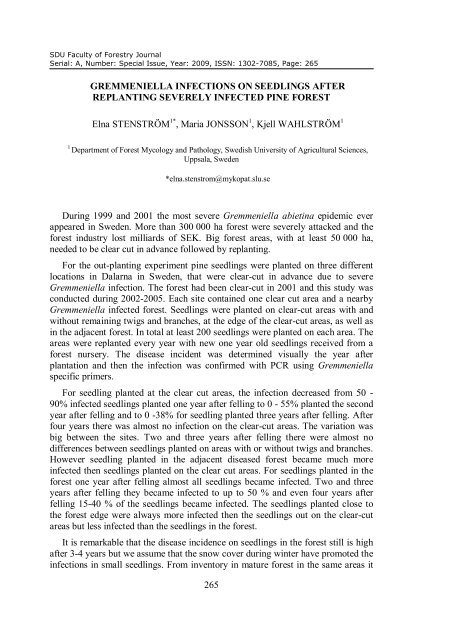sdu faculty of forestry journal special edition 2009 - Orman Fakültesi
sdu faculty of forestry journal special edition 2009 - Orman Fakültesi
sdu faculty of forestry journal special edition 2009 - Orman Fakültesi
Create successful ePaper yourself
Turn your PDF publications into a flip-book with our unique Google optimized e-Paper software.
SDU Faculty <strong>of</strong> Forestry Journal<br />
Serial: A, Number: Special Issue, Year: <strong>2009</strong>, ISSN: 1302-7085, Page: 265<br />
GREMMENIELLA INFECTIONS ON SEEDLINGS AFTER<br />
REPLANTING SEVERELY INFECTED PINE FOREST<br />
Elna STENSTRÖM 1* , Maria JONSSON 1 , Kjell WAHLSTRÖM 1<br />
1 Department <strong>of</strong> Forest Mycology and Pathology, Swedish University <strong>of</strong> Agricultural Sciences,<br />
Uppsala, Sweden<br />
*elna.stenstrom@mykopat.slu.se<br />
During 1999 and 2001 the most severe Gremmeniella abietina epidemic ever<br />
appeared in Sweden. More than 300 000 ha forest were severely attacked and the<br />
forest industry lost milliards <strong>of</strong> SEK. Big forest areas, with at least 50 000 ha,<br />
needed to be clear cut in advance followed by replanting.<br />
For the out-planting experiment pine seedlings were planted on three different<br />
locations in Dalarna in Sweden, that were clear-cut in advance due to severe<br />
Gremmeniella infection. The forest had been clear-cut in 2001 and this study was<br />
conducted during 2002-2005. Each site contained one clear cut area and a nearby<br />
Gremmeniella infected forest. Seedlings were planted on clear-cut areas with and<br />
without remaining twigs and branches, at the edge <strong>of</strong> the clear-cut areas, as well as<br />
in the adjacent forest. In total at least 200 seedlings were planted on each area. The<br />
areas were replanted every year with new one year old seedlings received from a<br />
forest nursery. The disease incident was determined visually the year after<br />
plantation and then the infection was confirmed with PCR using Gremmeniella<br />
specific primers.<br />
For seedling planted at the clear cut areas, the infection decreased from 50 -<br />
90% infected seedlings planted one year after felling to 0 - 55% planted the second<br />
year after felling and to 0 -38% for seedling planted three years after felling. After<br />
four years there was almost no infection on the clear-cut areas. The variation was<br />
big between the sites. Two and three years after felling there were almost no<br />
differences between seedlings planted on areas with or without twigs and branches.<br />
However seedling planted in the adjacent diseased forest became much more<br />
infected then seedlings planted on the clear cut areas. For seedlings planted in the<br />
forest one year after felling almost all seedlings became infected. Two and three<br />
years after felling they became infected to up to 50 % and even four years after<br />
felling 15-40 % <strong>of</strong> the seedlings became infected. The seedlings planted close to<br />
the forest edge were always more infected then the seedlings out on the clear-cut<br />
areas but less infected than the seedlings in the forest.<br />
It is remarkable that the disease incidence on seedlings in the forest still is high<br />
after 3-4 years but we assume that the snow cover during winter have promoted the<br />
infections in small seedlings. From inventory in mature forest in the same areas it<br />
265








